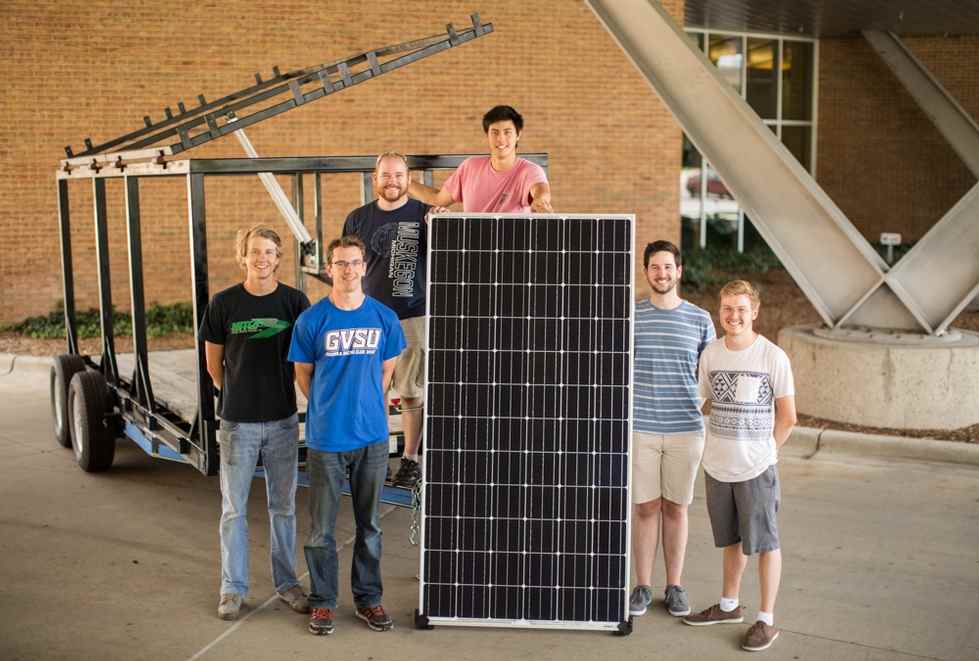Sustainability Summer 2016
Sunny-side up
Solar Garden plants learning opportunities
by Leah Twilley
The solar power plant on the Allendale Campus, which began operating in April, isn’t just producing solar energy but also learning opportunities for the campus community.
The 17-acre, 11,200-panel plant, located south of Pierce Street near 48th Avenue, is the largest community solar project in Michigan. The site, owned and operated by Consumers Energy through its Solar Gardens program, provides electricity produced by solar energy to enrolled customers in West Michigan, including Grand Valley. The university subscribed to 500 kilowatts, which will produce 750,000-800,000 kilowatt hours per year.
Thanks to a $55,000 grant from Consumers Energy, students and faculty members at Grand Valley combined their brain power to design and build two transportable, solar energy-producing modules this summer. The structures were built and designed by a team of six students from the School of Engineering and a team from Grand Valley’s Muskegon Innovation Hub.
The unit created by the engineering team has the capacity to emit four kilowatts of electricity and serves as an educational tool to raise awareness about solar energy.
Team captain Alec Nichols, a mechanical engineering major, said the module travels to different sites in West Michigan to demonstrate the technology and collect data, which is made available on a public website. The group hopes the data can be used for research.
Eight solar panels and a collection of solar shingles — a fairly new technology — make up the portable system.
“Solar shingles are designed to replace traditional shingles on a house, so when you reroof your house, instead of using a regular shingle, you can opt into a solar shingle,” said Tyler Roelfsema, a mechanical engineering major. “The way in which they generate energy from the sun is the same process as solar panels.”

Engineering students created a solar energy module that can travel to demonstrate its technology while collecting data.
photo by Amanda Pitts
The unit, which took two months to build, spans 18 feet when it is fully set up. The panels are adjustable, so they can tilt in various directions to measure how different angles affect the system’s output.
During the design and building phases of the project, group members concentrated on different areas of the system: electrical, mechanical, software and web development, and educational programming.
Nichols said one of the group’s biggest design challenges was making the system operate off a grid.
“Most solar energy systems are tied to a grid system, like the solar power plant in Allendale,” he said. “One of the biggest parts of the systems is the inverter which takes power generated by panels and converts it into consumable electricity. We had to find a way around that with our free-standing system.”
Students were Roelfsema, Nichols, William Neuson, Benjamin Stenberg, John Wilks and Kevin Wu; they all graduated in August. Affiliate faculty member Terry Stevens served as the advisor.
The second solar energy module was built by Energy Partners, a tenant at the Muskegon Innovation Hub, formerly the Michigan Alternative and Renewable Energy Center. It includes solar panels and patented battery technology that allows the systems to provide electricity at all times.
The solar power plant will continue to serve as an extension of the classroom at Grand Valley. Consumers Energy will provide a $20,000 grant each year for the next six years for proposed interdisciplinary projects and curriculum.
A new course, Renewable Energy Management and Modeling, will train students in applied energy analysis using the plant as a case study. The site will be incorporated into the curriculum of more than 12 courses in engineering, environmental studies, statistics, natural resource management and biology.
Practical projects and research will include analyzing data generated at the garden, monitoring biotic and abiotic conditions of garden installation, creating awareness pieces and developing training for emergency personnel entering a home or business that has solar panel installations.
